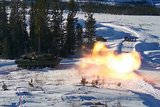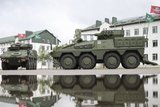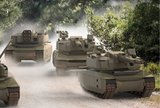AI3 control vehicle tests successfully completed
The Accelerated Improved Intercept Initiative (AI3) programme is reported to be on schedule and moving toward fielding following the successful completion of control test vehicle (CTV) flights. Raytheon and the US Army conducted the test flights as part of a company-led effort to demonstrate the effectiveness of the system elements.
The AI3 programme is being conducted in response to a US Army requirement for enhanced warfighter protection through the development of a system capable of destroying a wider array of incoming rockets, artillery and mortars than previously deployed solutions.
The CTV tests saw the Ku-Band Radio Frequency System (KRFS) fire control radar detect the inbound threat, determine that the threat would impact in a defended area, and provide command guidance via datalink to the AI3 missile.
Raytheon said that the AI3 missile then successfully manoeuvred on a calculated trajectory necessary to intercept the 107 mm rocket target. In subsequent missions, an onboard semiactive radar seeker will perform terminal guidance to target intercept.
Steve Bennett, AI3 program director, Raytheon, said: ‘With the completion of the CTV flights, the AI3 programme remains on schedule. Raytheon is committed to providing an affordable and highly effective solution to save warfighter lives.’
Lt. Col. Brett Wilhide, US Army project manager for AI3, added: ‘The AI3 programme has made excellent progress to date. We are now ready to progress to the guided test vehicle flight test phase of the programme. Those tests will demonstrate the full integration of the tactical AI3 battle element system to intercept threat targets.’
More from Land Warfare
-
Germany signs multi-billion-dollar deals for 6x6 CAVS and GDELS Eagle vehicles
The order is a further boost for the Common Armoured Vehicles System programme which has notched notable successes in the past 12 months. The first vehicle, made in Finland, will be delivered next year with local production expected to ramp up in 2027.
-
![Rheinmetall and KNDS tank tie-up narrows trans-European options]()
Rheinmetall and KNDS tank tie-up narrows trans-European options
The French and German governments signed an agreement in June 2018 to cooperate on the development of a new main battle tank under the Main Ground Combat System programme but the effort has struggled. This new agreement may damage it further.
-
![Hungary set to begin using Hero 400 loitering munitions]()
Hungary set to begin using Hero 400 loitering munitions
Developed by Israel's Uvision and with systems being sold in the thousands to multiple European NATO countries and the US, the Hero family of loitering systems is also in production in the US and Italy, the latter through Rheinmetall.
-
![Croatia orders Leopards and CAESAR howitzers as Lithuania orders more CAESARs]()
Croatia orders Leopards and CAESAR howitzers as Lithuania orders more CAESARs
The Leopard is becoming the tank of choice in central and eastern Europe as Croatia joins Lithuania, the Czech Republic and Hungary in ordering the platform. Lithuania and Croatia have also signed for CAESAR howitzers.
-
![Light Reconnaissance Strike – enabling a vital mission set (Studio)]()
Light Reconnaissance Strike – enabling a vital mission set (Studio)
A new system-of-systems concept will unlock digital integration of sensors and weapons for Light Forces, allowing them to shape the battlefield environment on their own terms and upgrade legacy platforms.


























